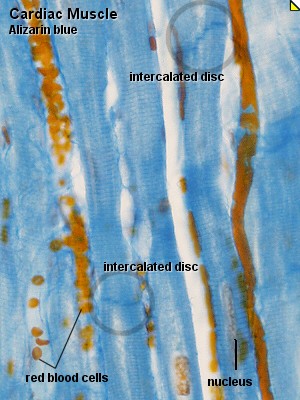File:Cardiac muscle histology.jpg
Cardiac_muscle_histology.jpg (300 × 400 pixels, file size: 42 KB, MIME type: image/jpeg)
Cardiac Muscle Histology
Primate - Alizarin blue
- Red Blood Cells (orange cells) Cardiac Muscle Cells (blue)
- Use a low magnification to find a part of the tissue in which the cardiac muscle cells are cut longitudinally.
- At high magnification you should see striations and the large nuclei of the cardiac muscle cells.
- Follow the course of individual cardiac muscle cells you will note fine, dark blue lines which seem to cross the fibres.
- These are the intercalated discs which connect the individual muscle cells and permit the conduction of electrical impulses between the cells.
- Links: Heart Histology | Cardiac AZB Labeled | Cardiac AZB | Cardiac label LS | Cardiac LS | Cardiac label TS | Cardiac TS | Purkinje fibres | Purkinje fibres detail | Histology
Links: Histology | Histology Stains | Blue Histology images copyright Lutz Slomianka 1998-2009. The literary and artistic works on the original Blue Histology website may be reproduced, adapted, published and distributed for non-commercial purposes. See also the page Histology Stains.
Cite this page: Hill, M.A. (2024, April 18) Embryology Cardiac muscle histology.jpg. Retrieved from https://embryology.med.unsw.edu.au/embryology/index.php/File:Cardiac_muscle_histology.jpg
- © Dr Mark Hill 2024, UNSW Embryology ISBN: 978 0 7334 2609 4 - UNSW CRICOS Provider Code No. 00098G
Original file name: Cam40ab.jpg
File history
Click on a date/time to view the file as it appeared at that time.
| Date/Time | Thumbnail | Dimensions | User | Comment | |
|---|---|---|---|---|---|
| current | 23:17, 16 August 2009 |  | 300 × 400 (42 KB) | S8600021 (talk | contribs) | Cardiac Muscle, primate - Alizarin blue Use a low magnification to find a part of the tissue in which the cardiac muscle cells are cut longitudinally. At high magnification you should see striations and the large nuclei of the cardiac muscle cells. If you |
You cannot overwrite this file.
File usage
The following 11 pages use this file:
- ANAT2241 Cardiovascular System
- ANAT2241 Muscle Tissue
- Cardiac Muscle Histology
- Cardiovascular - Venous Development
- Cardiovascular System - Heart Histology
- Cardiovascular System Development
- Foundations - Histology Cells and Tissues
- HM Practical - Cardiac Histology
- Histology
- Histology Stains
- Muscle Development
